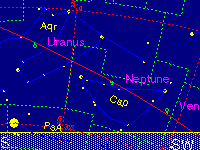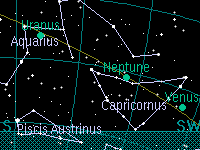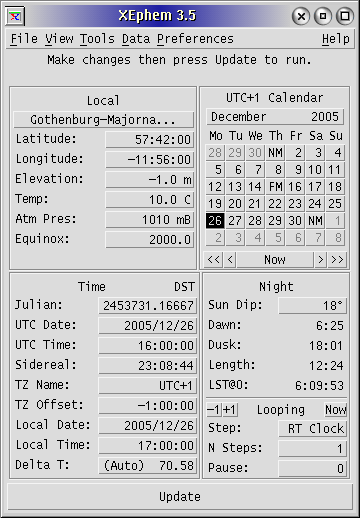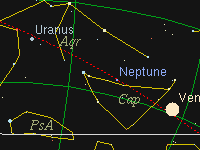

Active GUI element
Static GUI element
Code
WPS object
File/Path
Command line
Entry-field content
[Key combination]
Astronomy applications
This article is about sky
view
programs that you can use on eComStation or OS/2 to
predict what the sky will look like at a given time and position. There
are three such programs, all with their own style and capabilities:
PmAs, Night Vision, and XEphem.
Introduction
I have always been somewhat interested in astronomy, I also happen to live a short walk from the city observatory which makes it easy to go there and study heavenly bodies when the sky is clear and dark. I have an astronomical calendar book, but there are also several computer programs that will help to show a sky view at any given location and date. Such a program should at least let you save your usual location and automatically load the current sky map. It should also let you view in various directions (up, North, South-East, etc.) and easily step forward and backward in time by clicking a button or key: 30 seconds, 1 hour, 1 month, or whatever.
Not counting various web and Java programs, there are three programs I know of that run on eComStation or OS/2:
- PmAs - Astronomy for the Presentation Manager, version 1.12
- Night Vision, version 2.6
- XEphem, version 3.5
In the following, I use my position and time zone. The position is North 57°42', East 11°56', or in standard ISO 6709 notation +5742+01156/. This is rather close to the North pole so most Earthlings will have a rather different view of the sky. My time zone is UTC+1. The time selected is 2005-12-26 17:00. Then the Sun has just set, Venus, Neptune and Uranus is following (everything moves to the right), and Mars is high above the horizon. The viewing direction is South (azimuth 180°) with the horizon in the middle of the image (altitude 0°).
PmAs
PmAs is a freeware program by Cornelis Bockemühl. The current version is 1.12, date 2000-12-19. When asked about possible updates for the program, the author said that he was working on it but the switch to C++ and the IBM VisualAge C++ class library had taken more time than expected.
The program is packaged as five WarpIN
archives. When installing, I got the error WIDisp Error
Dosexecpgm returned 0.
I don't know why it happened but I
just ran the corresponding command files manually.
As installed, the program is a set of executable files. One of them, pmasesa.exe (Solar eclipses, Saros cycle), also needs the IBM VisualAge C++ runtime library file cppom30.dll that you have to find elsewhere. I got mine from an old VisualAge C++ installation. Unfortunately the PmAs help file does not work well with the eComStation help viewer (NewView). Some internal links open in the wrong window so they are hard to read. However, you can read the same documentation at the program's web site.
The installer also adds an Astro Symbol
font to the system. Something went wrong when I installed it, so it
ended up corrupted, but finally it worked after manual
installation.
PmAs adds several settings to the CONFIG.SYS file, so a reboot is recommended after installation. I have the following program folder, rearranged in a more logical way than it was originally.
Most objects open a settings notebook that you can use to do your calculations that produces a table or some graphics.

Fig. 1: The PmAs Folder [Larger image]
I added my position to the locations file (\PmAs\data\location.txt). It should be possible to do it from the program but I get a crash in the PmAs library file pmasclb.dll. The positions don't follow the ISO standard; the longitude comes before the latitude and the syntax is somewhat different, but it's easy to understand.
A simple program is Risings and Settings (pmasrist.exe). In the notebook that is opened when you start the program, you can select a celestial body such as the Sun from Planets (the Sun is no planet, but never mind) and a time interval.
You can set the output formats in Table output. This string creates a standard ISO 8601 date and time: %5y-%02o-%02dT%02h:%02m:%02s. A somewhat simpler string for human readers would be %5y-%02o-%02d %02h:%02m. This string formats the altitude with degree and minute: %v%2g°%02m. Unfortunately there's no option for decimal degrees as the standards recommend. Also select a Time interval, for instance the next 30 days. When done, do Calculate and you get a list of risings and settings as selected.
The program that shows the table is Pm Astro Tables (pmastab.exe). The font used in the table can be changed with the system font palette. There is no way to set a default font. The resulting table, like all tables, can be saved and later opened with View tables.
The help file mentions the REXX script inscfgen.cmd and the pmascfg.exe program for changing the settings. Unfortunately, none of them are in the current version, but supposed to be in the next one. Meanwhile some settings are still in CONFIG.SYS as mentioned above. The pmas.ini settings file in the cfg folder can be edited with any ini file editor.
Let's see how the current sky view is created.
- Open All Planets.
- Under Time, check that Time and Zone are correct (current time is set automatically by typing s in the time field)
- Under Graphic output make sure Graphic output is turned on
- Under Coordinates select Topocentric (default is Heliocentric which means you'll see what the sky looks like from the Sun)
- Under Location select your location, or Edit locations to create it (see above)
- Under Celestial body select All major planets (must be done after selecting topocentric coordinates)
- Finally, at the bottom, do Calculate
You'll again get a table showing the planets with their positions and
an image showing their positions. The image is created in the program Pm
Astro Graphics
and uses the file sky.gap
as its background.
The default viewing direction is right ascension 18 h, declination 66°30' North, same as latitude 66°30' North, longitude 90° East in sky coordinates. This means that the view is in right angle from the ecliptic plane (the Earth's orbit). This can of course be changed. The map is 3-dimensional so you can move around using the keyboard or you can set new coordinates. You can also create your own default maps with your own data.
You can add a horizon to see what the sky looks like tonight. Use the Local Horizon (pmashor.exe) program to draw your horizon, and then drag the All Planets view into it. You'll get a view facing South and you can move around, rotate and scale. Unlike the other two programs in this article, rotating can be done infinitely so you don't have to rotate back after 360 degrees!

Fig. 2: PmAs sky view
[Larger image]
The resulting graphics can be saved and later viewed and edited with View graphics (pmasgraf.exe).
There's no way of changing the time so you can follow the movements of the bodies. You have to make a new calculation for every new time. What you can do is an ephemeris, that is you can plot positions of one body at a given time interval. For example the Moon, every day at 21:00 for the next 30 days.
There is also an Earth map in the program, that is used to show where solar eclipses can be seen. You can move around just like you can with the sky map.
However, the graphics could be improved. The program reminds me of the ancient 16-colour DOS programs.
PmAs is perhaps not the easiest program to start with, and as
the author writes: If you are rather looking for some kind of
planetarium you may be better served with other programs.
But the program is modular so people can use program modules and build on them. For instance, the calculations could be presented in a prettier way with another graphics module.
Night Vision
Night Vision 2.6 is a freeware program by Brian Simpson. It is also available for Java, version 1.2, date 2005-01-02. They are very similar, but the OS/2 version is somewhat easier to work with and quicker (the usual differences). Up to version 2.5 it was a shareware program that costs 25 US dollars [€20] (Java version is free). There are also German and Russian language versions, both version 2.3 only.
Night Vision is almost the total opposite to PmAs. It's simple to work with and also very pretty, but limited in what it can do. The installation consists of getting the zip file from the home page or elsewhere. Unzip it into the directory where you want it, and run install.cmd, which will check that the files are OK and add a Night Vision icon to the desktop. Then you can add your location to location list (file nvsn.cty), but you can also set and save your position when the program is running. The file does not use standard notation, and the longitude is written before the latitude. It uses degrees and minutes. On the positive side, timezone is included and it has the pluses and minuses correct.
Start the program, set the timezone and location or position, and you have a view of the current sky. I also prefer 24-hour time setting, which is set in the Time menu.

Fig. 3: Night Vision sky view
[Larger image]
The first view is a part of the sky right up, facing South. You can easily move around, using the arrow keys. Zoom in and out using z and Z, respectively.
There are quite a few settings that are saved in the local INI
file nvsn.ini. For
instance, I added the ecliptic in the view and changed the
fonts from System Proportional
to WarpSans.
The main problem I have with Night Vision is that there is no
quick way to change the time. Either you open the time settings window
to select a new time, or you can set it to automatically fast-forward
the movements. This is also strictly a viewing program, so you won't
get any data out of it.
XEphem
XEphem is made by CSI (Clear Sky
Institute), currently at version 3.7.1. It's
mainly for Unix-like
systems but can be
made to run in an X window session on OS/2: XFree86
or HOBLink.
XEphem is partly freeware and open source. CSI makes parts of the sources available for download so you can compile it yourself. The sources are enough to run the program with many features. For a ready-to-run program with all features, you must purchase it, but there's no OS/2 (or Windows) version. However, some people have built OS/2 versions from the free source and made them available. The full copy of version 3.5 is available from Hobbes. It shouldn't be hard to compile a later version, but I haven't found out how to do it yet.
The program also needs LessTif. I'm using the latest version, 0.93.91, date 2003-10-22.
I run the program with HOBLink. There's no installation program included, just unzip it and it gets the usual (old style) XFree86 structure. Same with LessTif. There's an XEphem.cmd file in the \XFree86\bin directory that you can use to run the program. It requires the following library files, so they have to be installed: emx.dll, emxlibcm.dll, xt.dll, xm_20.dll, x11.dll. XEphem 3.5 also requires the EMX runtime library file gcc2952m.dll.
The default location list file is \XFree86\bin\xephem-3.5\GUI\xephem\auxil\xephem.sit. Again, it uses its own format instead of the standard, but at least the latitude comes first. In the user interface, East longitude are written as negative, which is also against the standard. Also, the TZ offset is counted West of UTC, which means that my time zone UTC+1 is written as -1.
I added my location there using a text editor. Then I started the program and selected my location under Local. I set:
- Preferences > Units > Metric
- Preferences > Time zone > Local
- Preferences > Equatorial > Topocentric
- Preferences > Start week on > Monday
- Preferences > Date format > M/D/Y
In the main window, I set TZ Name to UTC+1 and TZ Offset to -1:00:00.

Fig. 4: XEphem main window
The settings are saved in the file \home\default\XEphem\XEphem.
It also makes a backup copy of the last file called XEphem.bak, but I always get a Permission
denied
error unless I delete that file manually.
For some reason I have a problem with the time zone: TZ Name and TZ Offset are forgotten although they are written to the XEphem file. Also, pressing Now to set the program to the current time resets TZ Name and TZ Offset to default values which is annoying. I don't know if the problem is with XEphem, LessTif, or something else.
Anyway, for this demonstration I set:
- UTC Time to 16:00:00.
- Then I select View > Sky View
The window xephem Sky View is opened.
Control > Options brings up another window, Sky options, in which I set:
- Display Mode Alt-Az
- Grid Control RA-Dec
- View Options Equatorial plane and Ecliptic plane.
After leaving the window I set azimuth 180° (bottom scrollbar), and altitude 0° (right scrollbar). The result can be seen below:

Fig. 5: XEphem sky view
[Larger image]
Another feature in XEphem is very useful. You can step forward and backward in time at any rate. Just go to Step, that usually shows RT Clock, set it to any interval, for instance 24:00:00 (hours), and press +1 or -1, or use the shortcuts ctrl+f, ctrl+b. This is a great way to see how celestial bodies move and compare different times of the year, of the day, or whatever.
XEphem is packed with features that I haven't even tried yet. As it is widely used on Unix systems, there is a lot of info available from other sources.
Conclusion
Currently, I usually start Night Vision for a quick view, and move to XEphem when I want to have better control. PmAs is little used. However, given its modular design, it could be a basis for your own program. It also makes better use of OS/2 features than the other programs. With some improvement in time settings, Night Vision could be even more useful. I don't know if it will be developed further. XEphem would need to be compiled at the latest level, with the bugs corrected. An OS/2 native version would be great too. Otherwise it's a great program.





 Feature articles
Feature articles